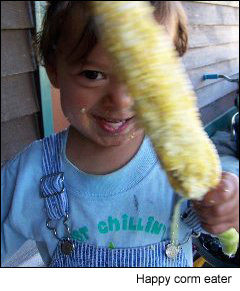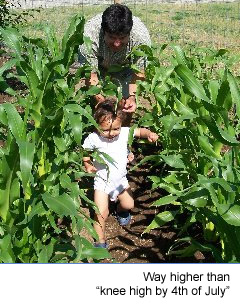GOT CORN? The van Buerens do!
By Jane Gilbertsen
 Who would have guessed that our local fishing expert Kevin van Bueren and his son Jackson knew the secret of getting sweet ripe corn this summer? Kevin and Jackson are willing to share their successful techniques with all Methow gardeners. Here's the story.... Who would have guessed that our local fishing expert Kevin van Bueren and his son Jackson knew the secret of getting sweet ripe corn this summer? Kevin and Jackson are willing to share their successful techniques with all Methow gardeners. Here's the story....
Group A - Kevin planted corn seeds in 72 tiny "pots" on APRIL 26th and placed the full flat in the south window in his sun room. When the sun became super hot he moved the flat to a west window. He used Lovingston Peaches and Cream corn seed from Twisp Feed Store. The seed sprouted in 8 days. The 5-14 inch starts were transplanted out on May 24th. The soil had been amended with 3 year's worth of compost and 7 bags of chicken manure, then rototilled, presoaked and rowed up. Around each start Kevin sprinkled organic fertilizer pellets on the day of planting and several times thereafter. The weather was cool and it rained 2 days later. June 2nd brought a very light frost which browned the edges only. (Even mid-June frosts were not uncommon in the Methow until just recently.)
 Group B and C - On May 30th Kevin and Jackson direct seeded more Lovingston Peaches and Cream (85 day per the package), Group B, and Early SunGlow (65 days), Group C. It was rainy and cool for a week except for one warm day. It sprouted on the 7th day. Kevin pointed out the spacing for each seed and Jackson planted each seed by plunging his finger deep into the loose damp soil. Jackson was 18 months at the time so you can guess the depth! Group B and C - On May 30th Kevin and Jackson direct seeded more Lovingston Peaches and Cream (85 day per the package), Group B, and Early SunGlow (65 days), Group C. It was rainy and cool for a week except for one warm day. It sprouted on the 7th day. Kevin pointed out the spacing for each seed and Jackson planted each seed by plunging his finger deep into the loose damp soil. Jackson was 18 months at the time so you can guess the depth!
Kevin's rows are lined up east/west and about 30 inches apart thereby giving room to til, weed and harvest. Each group was planted in a block but the blocks were all side by side in kind of an attractive arc (shorter stuff was planted to the south giving his garden a great look as you approach the house). The seeds were planted maybe 10 inches apart. A few were transplanted a second time because so many germinated and a few areas were crowded. One or two starts were moved to a separate location. They had no competition from other corn plants and they grew into a virtual bush loaded with ears. The "bush" was comprised of vigorous and productive sucker growth.  The suckers had such vigor they produced ripe ears themselves. "Experts" often recommend removing suckers because they take energy from the main producing stalk. This is probably more of an issue if each stalk is in competition for - sun, water and food. The suckers had such vigor they produced ripe ears themselves. "Experts" often recommend removing suckers because they take energy from the main producing stalk. This is probably more of an issue if each stalk is in competition for - sun, water and food.
The garden was watered daily with a light volume sprinkler for 30-60 minutes and the corn was fed 3x after feeding at time of planting. Corn is a notorious "heavy feeder". The tallest corn stalks grew farther away from the sprinkler and Kevin speculated through the summer that they might have gotten too much water. His rows are hoed up a few inches and the aisles are then, of course, lower. This should make some difference in both the dynamics of heat for germination and early growth and water distribution both drainage and root distribution. Corn needs heat/sun to germinate and of course water to grow, but once it gets going corn supposedly needs shaded roots. Which is not an issue when corn is typically grown in blocks and stalks shade each other. It doesn't explain the fine growth of the transplants growing in isolation (close enough for wind blown fertilization but not in competition for sun, water and food).
 See the photo of the corn picked 9/11/2010 See the photo of the corn picked 9/11/2010
From left to right:
Group B - the direct seeded Peaches and Cream
Group C - Early SunGlow
Group A - the transplanted Peaches and Cream
So what are the van Bueren secrets here? First, our weather is different every year. Corn seed, which ordinarily is considered to be good for only a year (germination of the fancy hybrids drops dramatically after a year), but is relatively inexpensive, so don't bet on consistent or typical weather. Buy a couple packets and try a couple different techniques - in pots and direct seed. Try early, midseason and maybe even late experiments. Try more than one kind. Maybe a short season variety (although planting different hybrid types of sweet corn within range of cross-pollination is tricky and more complex than I can go into here). Second, give each row some space and feed often. Third, use a kid for help to you and give a wonderful experience to the kid. Kevin learned corn cultivation from his Grandpa - fertilization, water and heat. Look what a wonderful experience he is passing on to the next generation. If necessary, borrow a kid. Maybe he or she will be your lucky charm in 2011!
Jane
Sept 21, 2010
|
